


In 2010, there were roughly 10.4 million patient visits to doctors' offices because of common knee injuries such as fractures, dislocations, sprains, and ligament tears. Knee injury is one of the most common reasons people see their doctors.
Your knee is a complex joint with many components, making it vulnerable to a variety of injuries. Many knee injuries can be successfully treated with simple measures, such as bracing and rehabilitation exercises. Other injuries may require surgery to correct.
AnatomyThe knee is the largest joint in the body, and one of the most easily injured. It is made up of four main things: bones, cartilage, ligaments, and tendons.
Your knee is made up of many important structures, any of which can be injured. The most common knee injuries include fractures around the knee, dislocation, and sprains and tears of soft tissues, like ligaments. In many cases, injuries involve more than one structure in the knee.
Pain and swelling are the most common signs of knee injury. In addition, your knee may catch or lock up. Many knee injuries cause instability — the feeling that your knee is giving way.
The most common bone broken around the knee is the patella. The ends of the femur and tibia where they meet to form the knee joint can also be fractured. Many fractures around the knee are caused by high energy trauma, such as falls from significant heights and motor vehicle collisions.
For more information about common fractures of the knee:
Patellar (Kneecap) Fractures
Distal Femur (Thighbone) Fractures of the Knee
Fractures of the Proximal Tibia (Shinbone)
A dislocation occurs when the bones of the knee are out of place, either completely or partially. For example, the femur and tibia can be forced out of alignment, and the patella can also slip out of place. Dislocations can be caused by an abnormality in the structure of a person's knee. In people who have normal knee structure, dislocations are most often caused by high energy trauma, such as falls, motor vehicle crashes, and sports-related contact.
For more information about knee dislocation:
Unstable Kneecap
Patellar Dislocation and Instability in Children (Unstable Kneecap)
The anterior cruciate ligament is often injured during sports activities. Athletes who participate in high demand sports like soccer, football, and basketball are more likely to injure their anterior cruciate ligaments. Changing direction rapidly or landing from a jump incorrectly can tear the ACL. About half of all injuries to the anterior cruciate ligament occur along with damage to other structures in the knee, such as articular cartilage, meniscus, or other ligaments.
For more information about ACL injuries:
Anterior Cruciate Ligament (ACL) Injuries
ACL Injury: Does It Require Surgery?
The posterior cruciate ligament is often injured from a blow to the front of the knee while the knee is bent. This often occurs in motor vehicle crashes and sports-related contact. Posterior cruciate ligament tears tend to be partial tears with the potential to heal on their own.
For more information about PCL injuries:
Posterior Cruciate Ligament Injuries
Injuries to the collateral ligaments are usually caused by a force that pushes the knee sideways. These are often contact injuries. Injuries to the MCL are usually caused by a direct blow to the outside of the knee, and are often sports-related. Blows to the inside of the knee that push the knee outwards may injure the lateral collateral ligament. Lateral collateral ligament tears occur less frequently than other knee injuries.
For more information about collateral ligament injuries:
Sudden meniscal tears often happen during sports. Tears in the meniscus can occur when twisting, cutting, pivoting, or being tackled. Meniscal tears may also occur as a result of arthritis or aging. Just an awkward twist when getting up from a chair may be enough to cause a tear, if the menisci have weakened with age.
For more information about meniscal tears:
The quadriceps and patellar tendons can be stretched and torn. Although anyone can injure these tendons, tears are more common among middle-aged people who play running or jumping sports. Falls, direct force to the front of the knee, and landing awkwardly from a jump are common causes of knee tendon injuries.
For more information about tendon tears:
Patellar Tendon Tear
Quadriceps Tendon Tear
When you are first injured, the RICE method -- rest, ice, gentle compression and elevation - can help speed your recovery.
Be sure to seek treatment as soon as possible, especially if you:
The type of treatment your doctor recommends will depend on several factors, such as the severity of your injury, your age, general health, and activity level.
Many knee injuries can be treated with simple measures, such as:
Many fractures and injuries around the knee require surgery to fully restore function to your leg. In some cases - such as many ACL tears — surgery can be done arthroscopically using miniature instruments and small incisions. Many injuries require open surgery with a larger incision that provides your surgeon with a more direct view and easier access to the injured structures.
Source: http://orthoinfo.aaos.org/topic.cfm?topic=A00325
We are Vaccinated
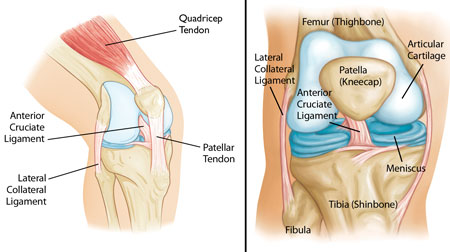 Different views of the normal anatomy of the knee.
Different views of the normal anatomy of the knee.
 Patellar fracture.
Patellar fracture.
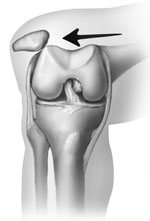 Patellar dislocation.
Reproduced with permission from The Body Almanac. © American Academy of Orthopaedic Surgeons, 2003.
Patellar dislocation.
Reproduced with permission from The Body Almanac. © American Academy of Orthopaedic Surgeons, 2003.
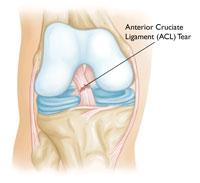 Anterior cruciate ligament tear.
Anterior cruciate ligament tear.
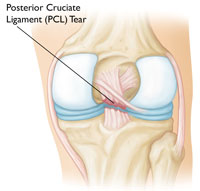 Posterior cruciate ligament tear (shown from back of knee).
Posterior cruciate ligament tear (shown from back of knee).
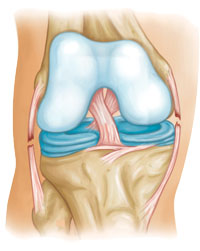 Tears of the medial and lateral collateral ligaments.
Tears of the medial and lateral collateral ligaments.
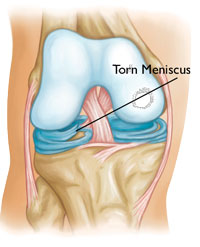 Meniscal tear.
Meniscal tear.
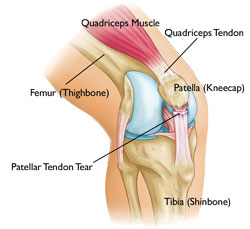
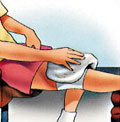
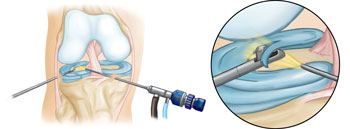 (Left) Knee arthroscopy. (Right) Close-up of an arthroscopic meniscal surgery.
(Left) Knee arthroscopy. (Right) Close-up of an arthroscopic meniscal surgery.
